
 |
Eager Space | Videos by Alpha | Videos by Date | All Video Text | Support | Community | About |
|---|

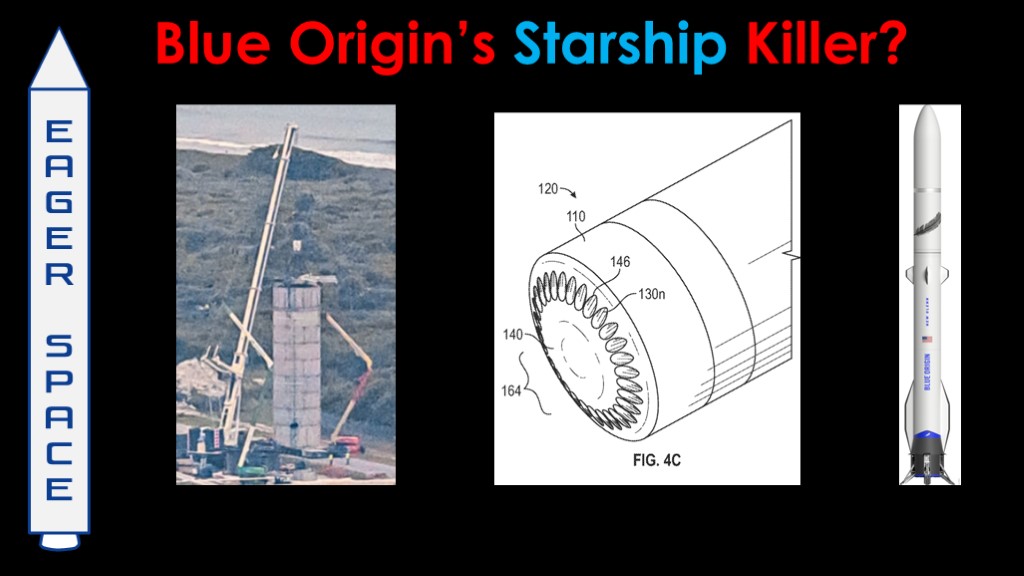
Blue Origin Patent
https://patents.google.com/patent/US20230211900A1/en
NASA paper on active cooling
https://ntrs.nasa.gov/citations/19930003270
Rocket Nozzle Types - an Ex Rocket Man's take on it
https://exrocketman.blogspot.com/2023/02/rocket-nozzle-types.html
Video link after - Space - you know rocket nozzles.

Today we're going to talk about Blue Origin's project Jarvis, also apparently known as project clipper.
It's a project to put a reusable second stage on Blue Origin's New Glenn Rocket.
For a long time I had resisted doing a video on this project because Blue Origin has been their usual secretive selves and so little was known, but I found a source of information around what is probably project Jarvis. Or at least was at one time.

AFAICT, the word "Jarvis" first came out in this article by Eric Berger in July of 2021.

It was accompanied by a picture of this test tank that was seen at Blue Origin's launch complex 36 in Florida.
And wow if it doesn't look a lot like Starship SN4.
It does seem like Blue Origin is playing on hard mode - a reusable second stage is very challenging for a company that has yet to reach orbit. But I thought about it a bit more...
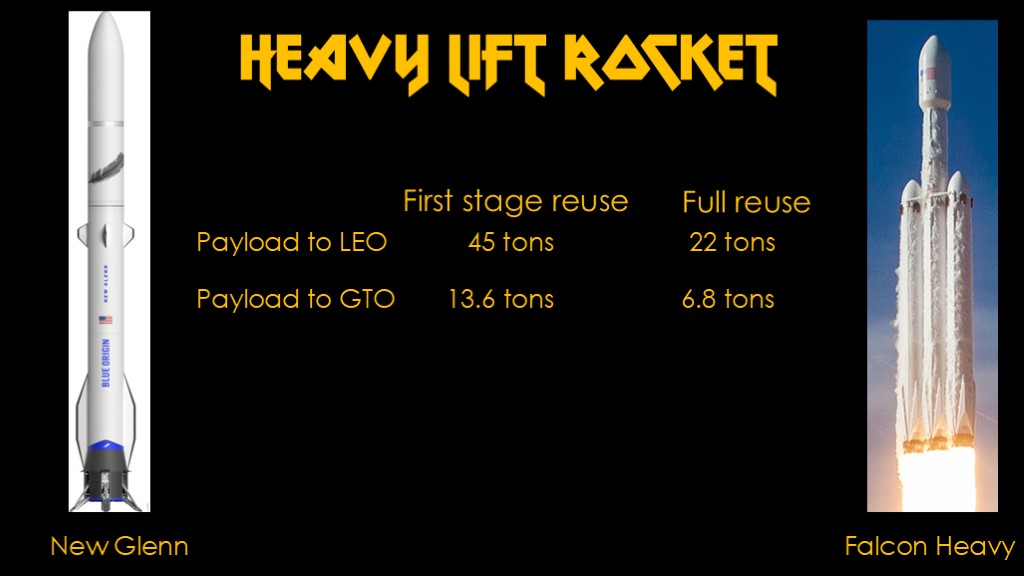
New Glenn is a strangely large rocket. The published specs say that with first stage reuse, it can do 45 tons to low earth orbit and 13.6 tons to geosynchronous transfer orbit.
That puts it in the heavy lift rocket class, and the payloads it carries will be pretty similar to those carried by Falcon Heavy. Falcon Heavy doesn't fly very often; most payloads are smaller and can be carried by Falcon 9. But there's no smaller option for New Glenn.
That means it's probably decent for carrying constellation satellites, but it's too big for a lot of other payloads. A very strange size - Falcon Heavy only ended up that size accidentally.
But if you added in a reusable second stage - one that cost 50% of the payload - that puts the payload down into a more interesting range, with payload a bit bigger than Falcon 9 in reusable mode.
That suddenly makes it a much more interesting rocket - a medium lift fully reusable rocket likely beats a heavy lift partially reusable rocket.
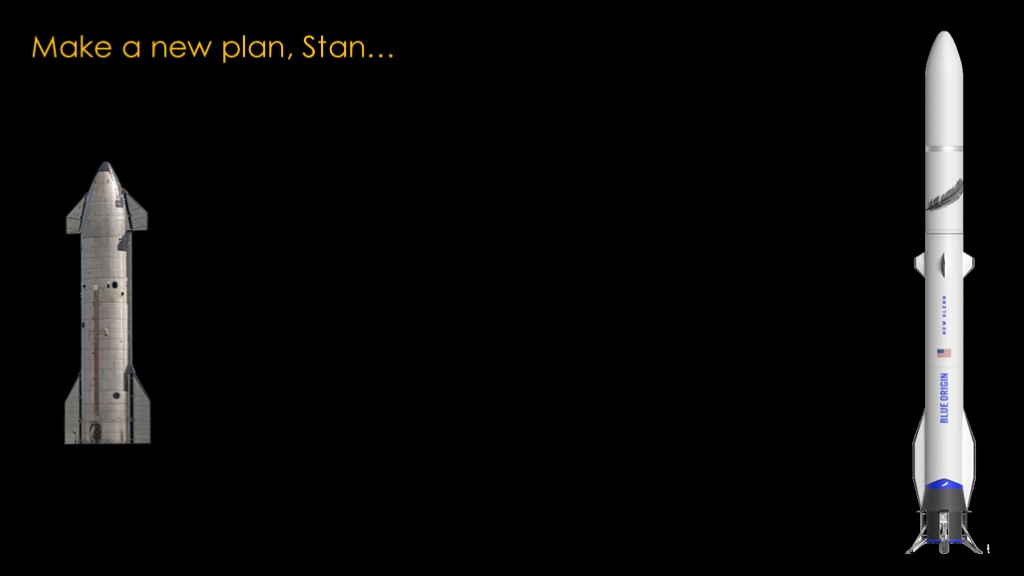
What is blue origin planning to do?
I think the general assumption was that Blue Origin was planning on taking the first stage of new glenn, taking the starship design and shrinking it down by about 25%, and putting it on top of the booster.
The fact that their test tank looked so much like a starship test tank appeared to be confirmation.
But I don't think that is the plan...
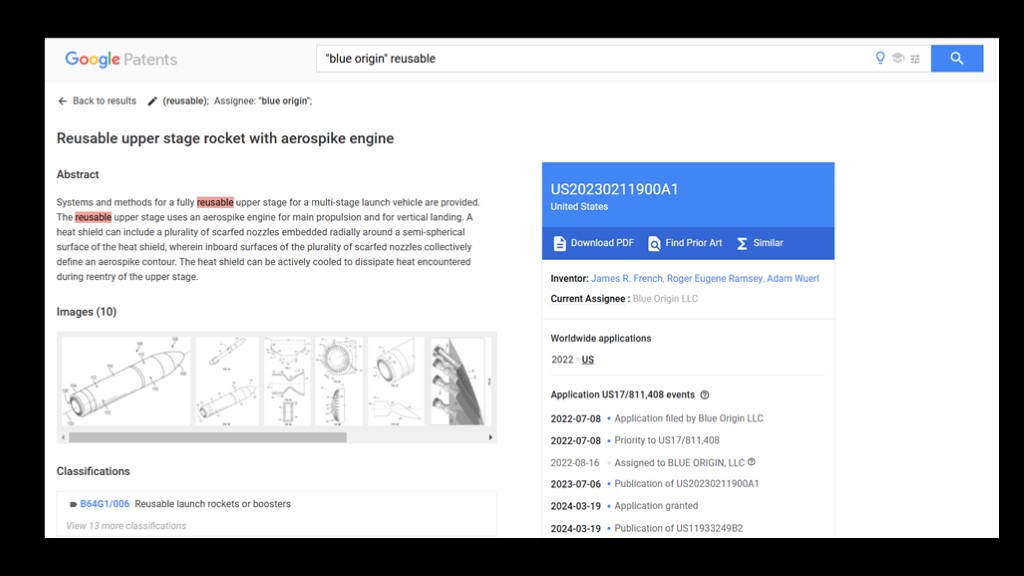
Unlike SpaceX, Blue Origin does believe in rocket patents, and here's an interesting one for a reusable upper stage rocket with an aerospike engine.
It's important to remember that there are many reasons to file patents - including to confuse your competitors - and therefore this is going to be speculative.
But it's the only detailed data I've been able to find, so we'll end up either somewhat enlightened or somewhat confused...
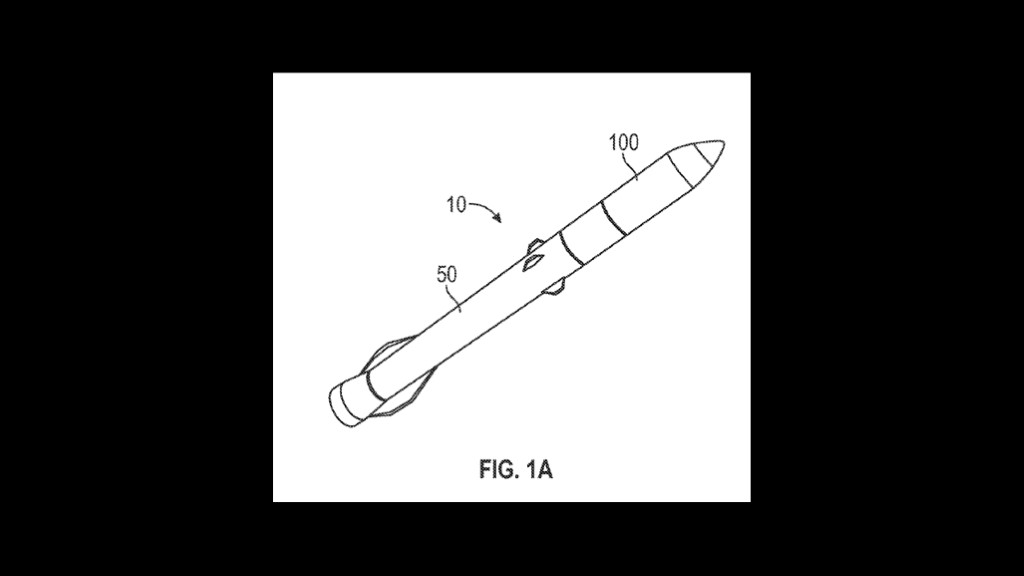
One of the pictures in the patent application shows the reusable stage "100" on top of a first stage which is very obviously New Glenn.
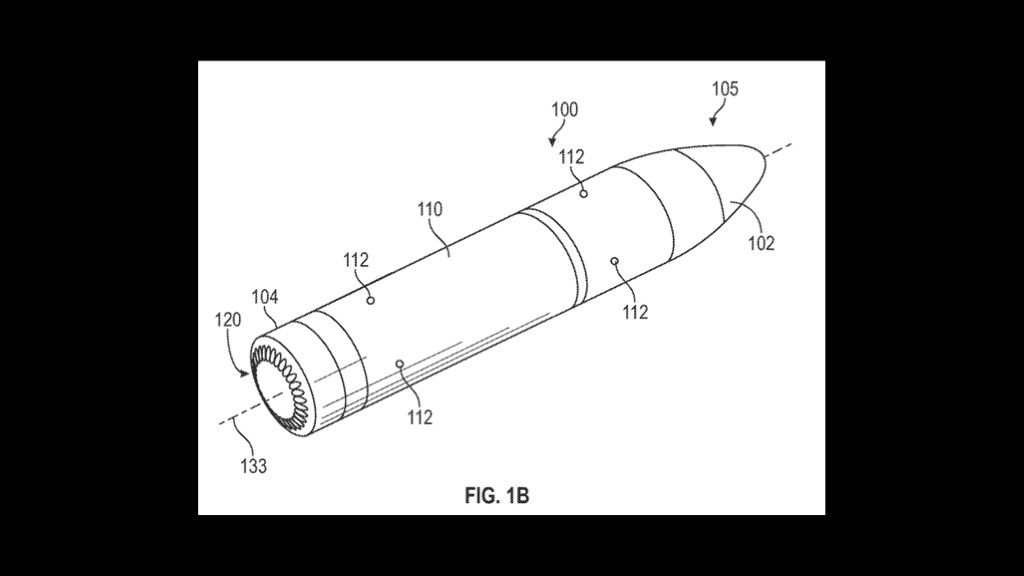
And here's what the stage looks like. The patent doesn't really talk about payload fairings so it's not clear what their plan is there; the second stage is the lower part, the one labelled 110.
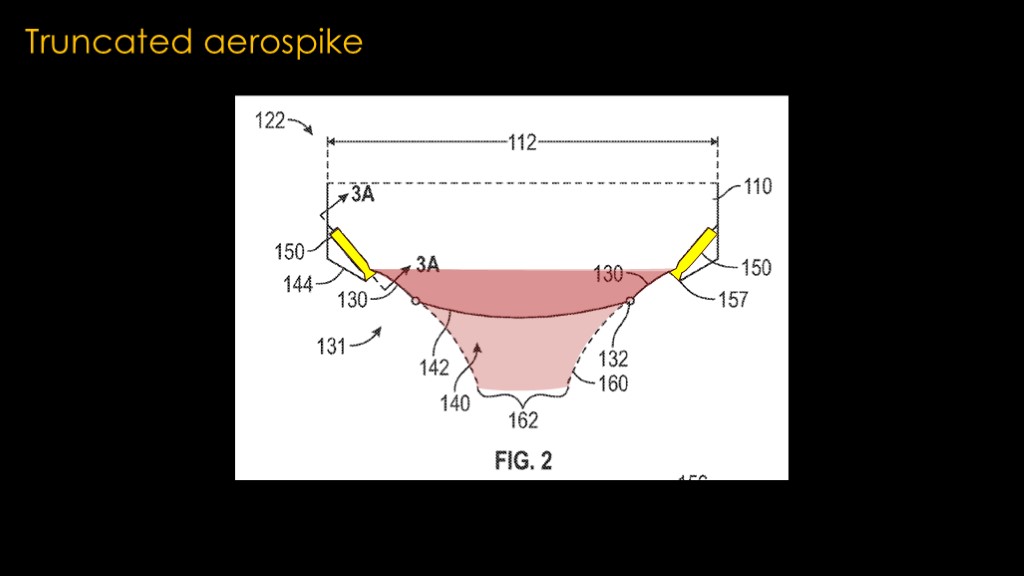
The engine is a what is known as a truncated aerospike.
Small rocket nozzles - they call them thrust modules - are pointed inwards at an angle so that the curve of the aerospike functions as one side of the nozzle and the other side is created by the atmosphere.
This aerospike shape would be a poor choice for reentry as it would be hard to keep cool, so they have further truncated the spike. Whether it still counts as an aerospike is an open question.
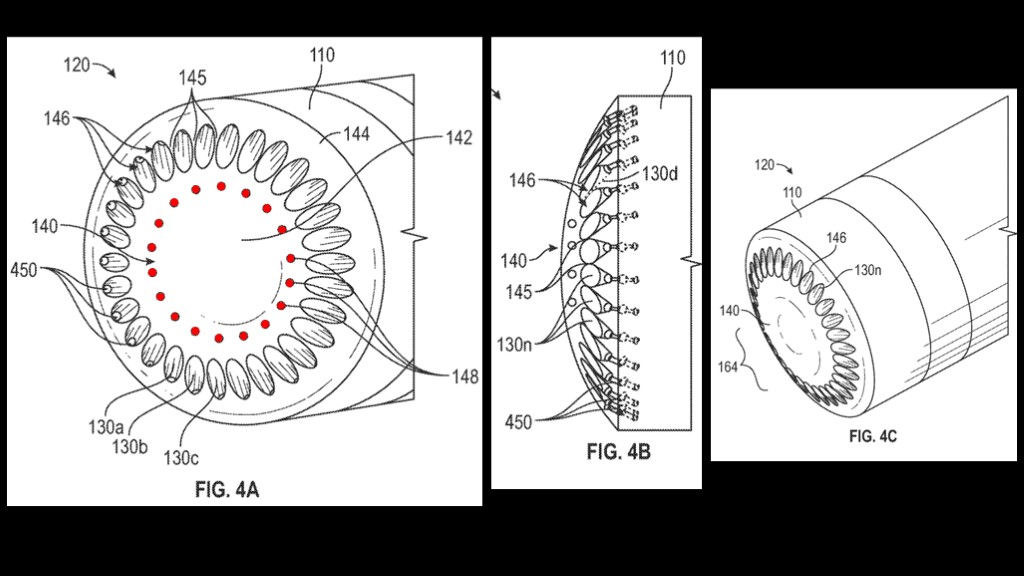
Here are some other drawings that make the design clearer. The patent mentions a "plurality of thruster modules" and further details that there might be anywhere from 20 to 150, or even numbers out side of that range.
There are holes in the heat shield - shown in red - that can be used to inject more gas or propellant to keep the center heat shield cool enough, and it may also have active cooling underneath.
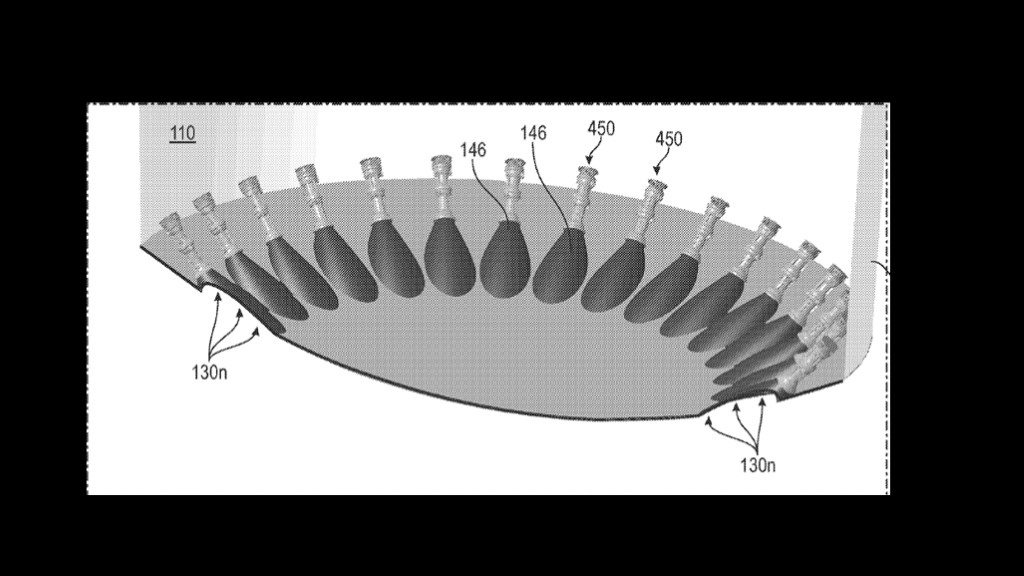
Here's a side view that shows the bottom of the stage and the thrust modules.
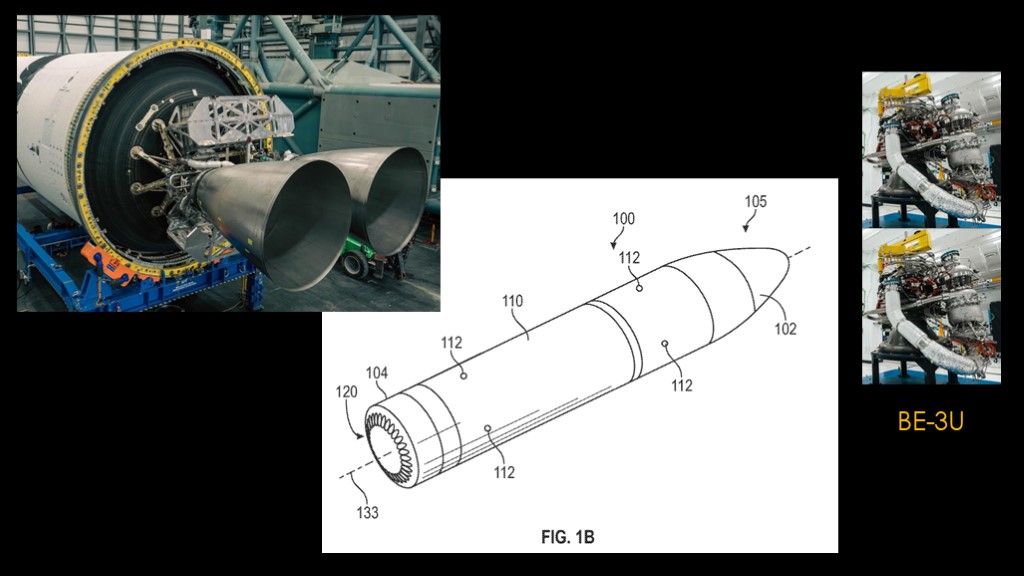
Instead of the two standard BE-3U engines planned for the New Glenn upper stage, this design would use two BE-3U power packs - everything except the combustion chamber and nozzle - to feed all of the thruster modules in the ring
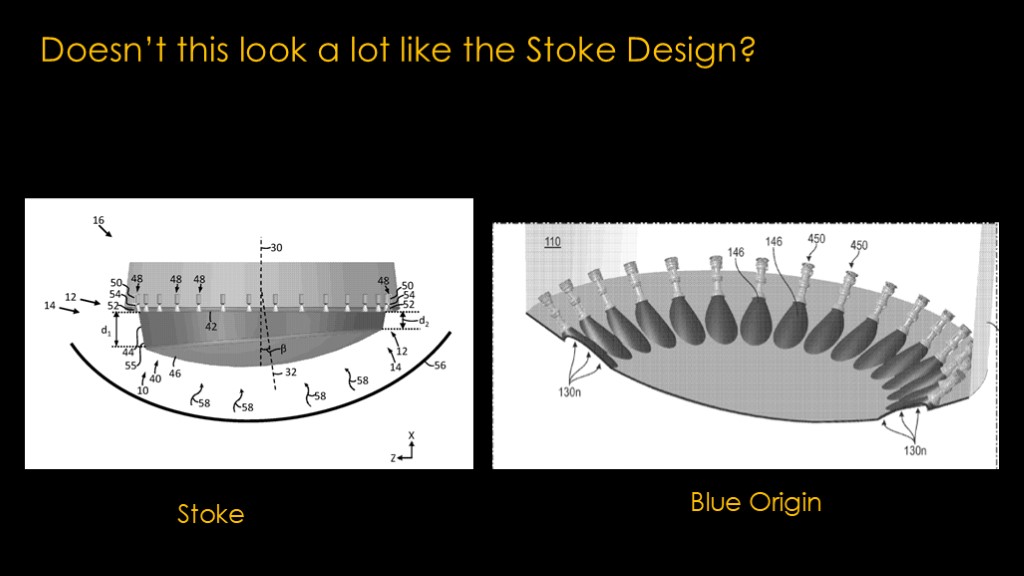
At this, you might be asking yourself "Doesn't this look eerily similar to the Stoke design?" And the answer is yes, for a fairly simple reason...
To reuse your second stage, there are two big requirements:
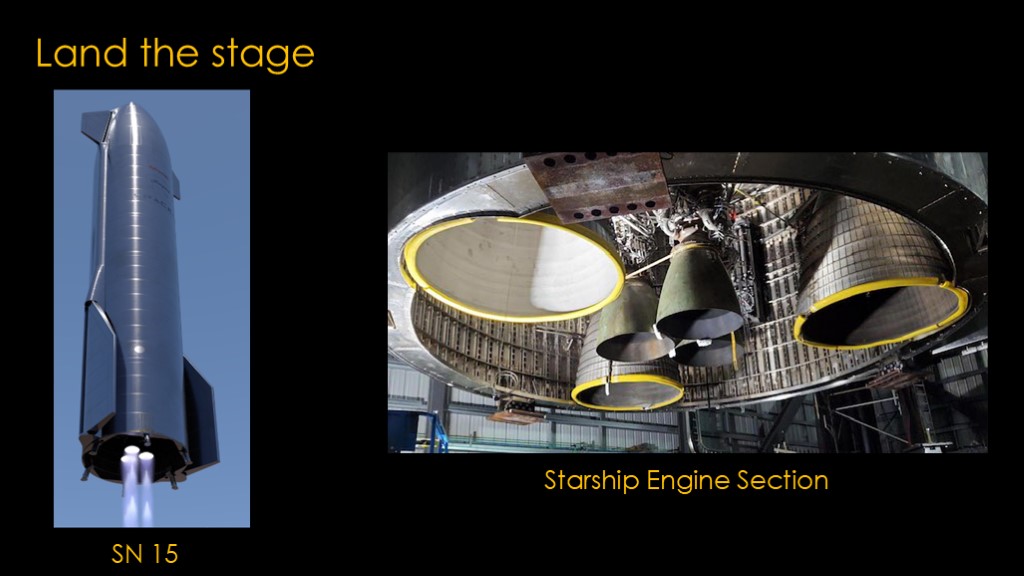
The first is to be able to land the stage. I'm going to assume that you are using engines to land it, which means that you need engines that you will run reliably at sea level. This is why starship has both highly efficient vacuum engines and less efficient sea level engines - the sea level engines are required to perform the landing operations.
Right now the mix is 3 sea level, 3 vacuum, but it's likely that starship will switch to 3 sea level, 6 vacuum in future versions.

The second issue for reusability is being able to make it through reentry. Starship comes in mostly sideways and that allows them to tuck the engines into the rear part of the stage and protect them from reentry heat with the same tiles that protect the rest of the ship.
It adds weight but allows them to use engines with standard bell nozzles.
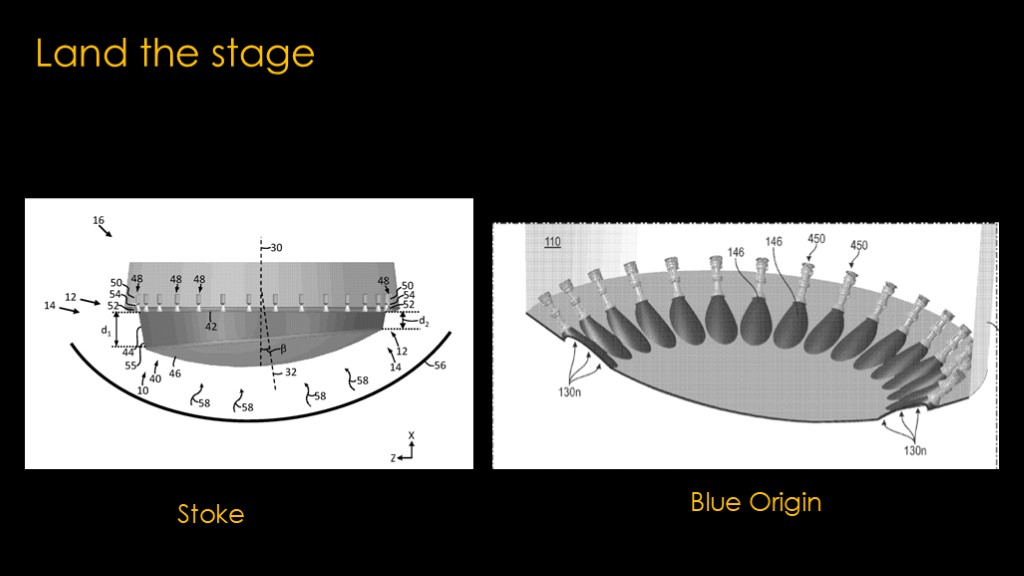
Stoke and Blue origin are using an approach where their engines work all the way down to sea level, which means they can get away with one type of engine for all the flight and for the landing, which is a useful simplification.

But to make it through reentry they are entering a new ground with a technology nobody has every tried before.
This design is a natural outgrowth of their decision to skip tiles and reenter butt first.
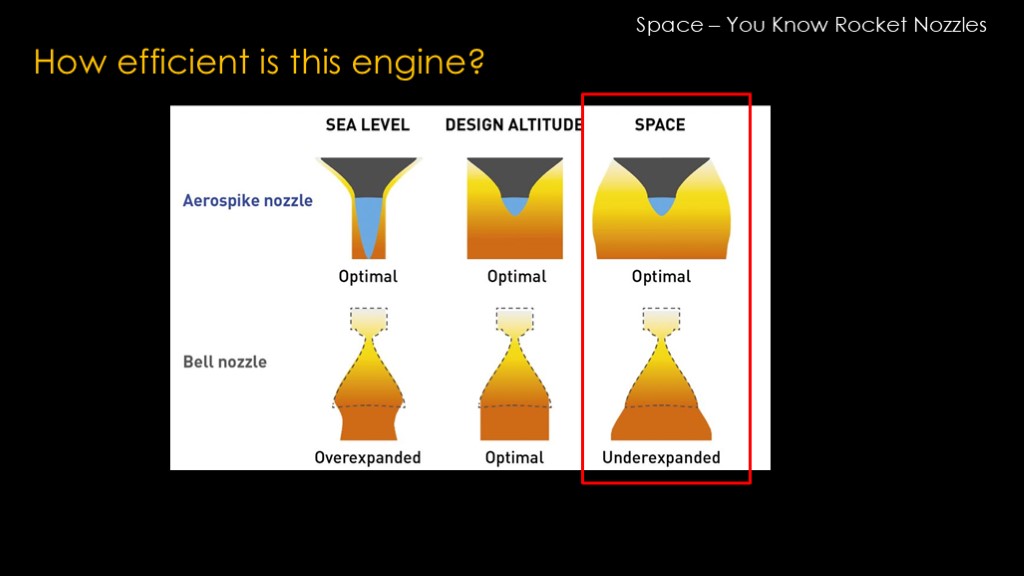
There's a very interesting question about engine efficiency between the SpaceX bell nozzle approach and the stoke/Blue Origin aerospikey approach. For the sake of argument, I'm going to assume that the latter both give you aerospike efficiency.
I've talked briefly about aerospikes in the past - see my video "space - you know rocket nozzles" - so I won't go into the topic too deeply here.
The assertion is that the traditional bell nozzle is optimal only at a specific altitude but the aerospike is optimal at all altitudes, and that the reason rockets don't use aerospike designs is either other concerns having to do with cooling or excess mass or due to a conspiracy, presumably by "big nozzle".
There is a real discussion to be had about the different designs, but the important point here is that we are dealing with second stages and what we care about most is the engine's efficiency when it is operating in vacuum.
So the question is "how will aerospike designs - and presumably these designs - perform as second stages that are only operating in vacuum?"

That's a hard question to answer because the majority of the discussion is about the performance as a first stage engine since we already know how to build vacuum engine nozzles and the air-pressure adaptation feature of aerospikes doesn't help you there.
Which left me with some assertions that aerospikes performed worse than vacuum nozzles but not a lot of real data, and I try to avoid being based on assertions.
Then I happened to come across a post on rocket nozzle types on a blog called, "an ex rocket man's take on it". This blog is written by Gary Johnson, an engineer who used to design rocket nozzles for a living. See the video description for a link.

The blog post is long and involved with a ton of details, but basically he benchmarked a LOX/RP-1 kerosene gas generator engine with both a conventional nozzle and an aerospike.
And then, just for fun, he benchmarked a vacuum nozzle, which obviously would not work for a sea level engine.
The data shows up in this chart, and it's one with a surprising conclusion. Note that we ignore all the low altitude stuff because we only care about vacuum performance.
It's a little hard to read the graph, but what he found is that the vacuum bell nozzle gave a specific impulse of 335, a sea-level bell gave specific impulse of 315, and an aerospike nozzle gave a specific impulse of 290. That the vacuum bell worked better was not a big surprise to me, but that a sea level bell beat the aerospike so easily was a significant surprise.
Plugging those numbers into my Falcon 9 model, I found that the vacuum bell would give a fully-expendable payload of 20.8 tons, the sea level bell would give a payload of 18.2 tons, and the aerospike would only give a payload of 14.9 tons.
That's a reduction of 28% with the aerospike design compared to a full vacuum design. You will be throwing away a lot of payload, and since you are going to reuse the first stage, you will be staging low so your second stage will need to a do a lot of work to get into space.
That is, of course, assuming these designs behave like aerospikes, and they might not. The Blue Origin design has the thrust modules pointing in and really looks like it wants to be an aerospike, but the stoke design looks to have them pointing straight down, so that design may behave more like a whole bunch of normal modules.
My uninformed guess is that the ultimate performance is going to depend on the nozzle size on each of the thrust modules, but bigger nozzles have obvious disadvantages.
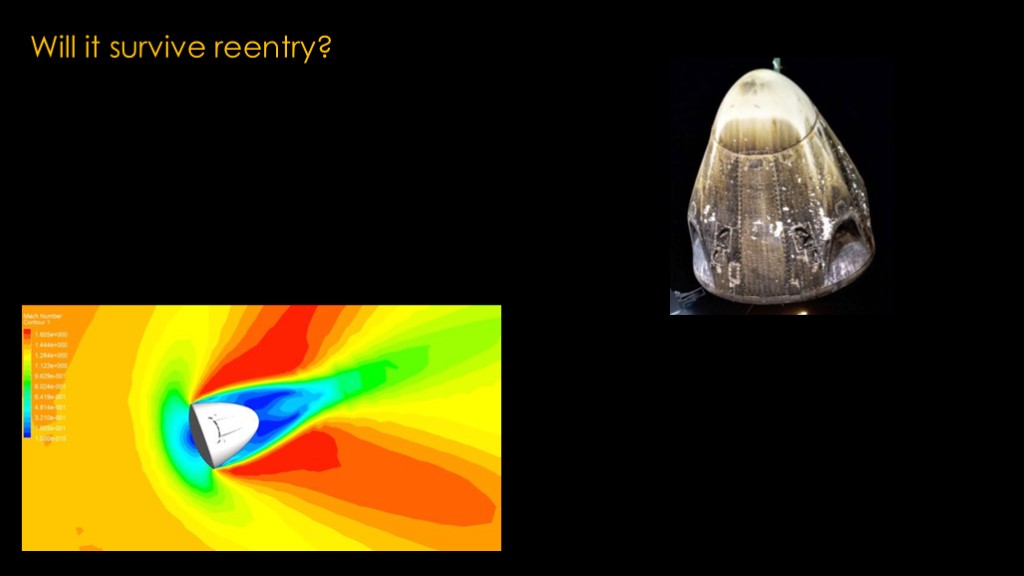
Another question is whether the Jarvis design will survive reentry?
Capsules tend to be widest at the base and short, and they are built this way so that the high temperature gas created in front of the heat shield doesn't damage the capsule higher up. Here's a simulation of a SpaceX dragon reentering, and it shows that the sides of the capsule stay in the cool gas.
Even with that, Dragon does not reenter unscathed.
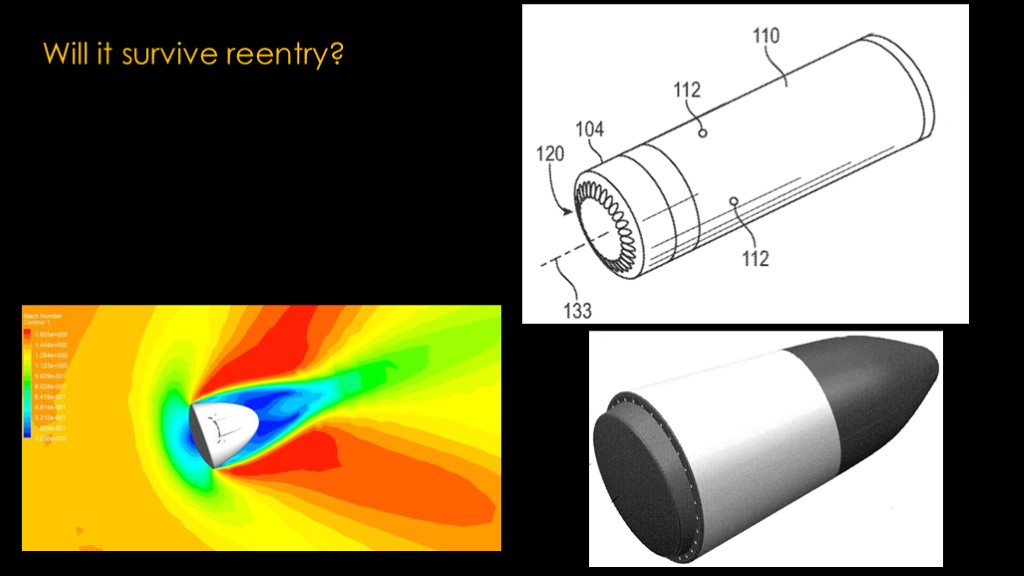
This second stage is straight on the side. It will have the benefit of the thrusters pushing the hot gas out to the side, but it will have to push it out quite a bit to keep it away from the upper part of the stage. That means a lot of propellant use.
This is based on the fairing not coming along for reentry. If the longer fairing is there that makes the problem harder.
The Stoke design uses a shape that is much more capsule shaped and will likely have fewer reentry heating issues.

Another possible issue is the frontal area. Coming in end-wise, the area of the back of the rocket is 63 square meters.
Coming in sideways, the area is 105 square meters. And that's not taking into account of the extra area control fins would add.
Smaller area means faster reentry and higher heating levels. Not good.
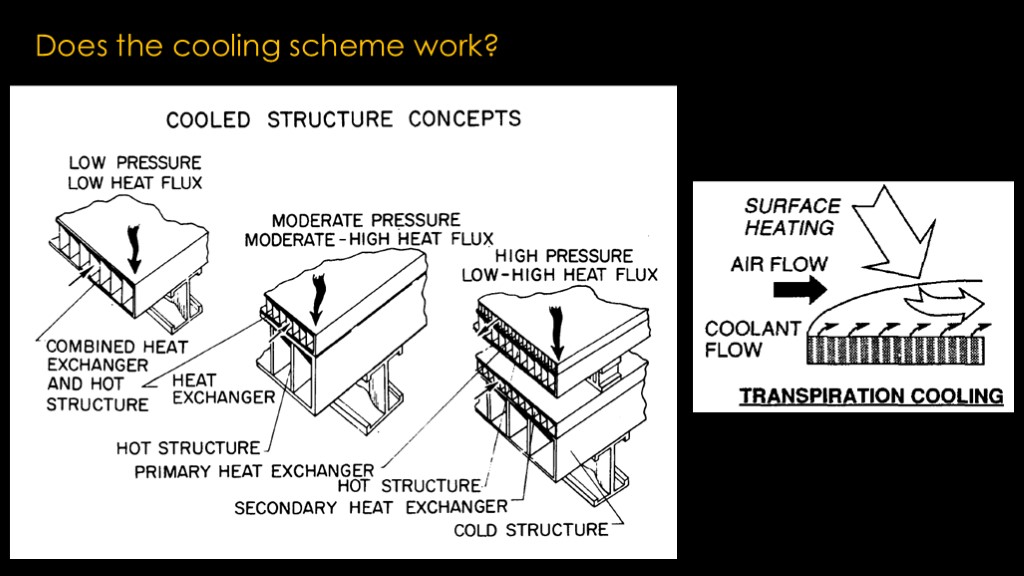
Does the cooling scheme works - does active cooling reduce the heat enough to make it practical?
NASA and others have explored cooled structure concepts and transpirational cooling, but there's not any real applications of these approaches as far as I know, so it will require development time and money.

And that's the story of Project Jarvis slash clipper - at least as much of the story I've been able to figure out.
A reusable second stage is a good fit for New Glenn, but it appears that they are trying a new concept that nobody has tried before, which will definitely take a lot of time and effort to develop.
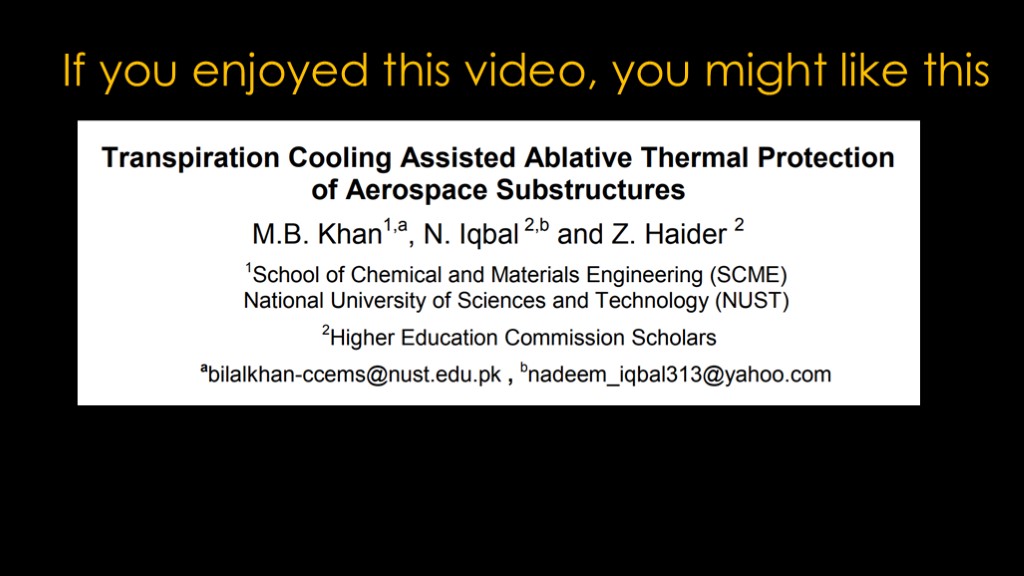
If you enjoyed this video, you might like this research paper...